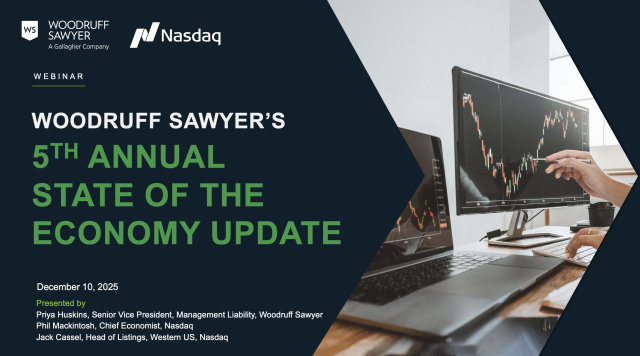Blog
Quarterly Quiet Periods: Myths versus Risk Mitigation
Quiet periods aren’t legal mandates for quarterly earnings—but they’ve become a cornerstone of disciplined disclosure practice. In an age of instantaneous communication, social media sound bites, and persistent analyst pressure, the risk of a stray remark or selective disclosure is higher than ever. This week, my colleague Lenin Lopez clarifies what quiet periods really are, why they exist, and how companies can use them as a governance tool to reduce litigation, regulatory, and reputational exposure. —Priya Huskins
For the uninitiated, quiet periods can feel overly prescriptive and restrictive. While they aren’t legally required in the context of the quarterly earnings process, quiet periods remain widespread precisely because they help solve practical and costly problems: potential Regulation Fair Disclosure (Reg FD) violations, litigation risk, analyst pressure to “confirm” outdated models, and reputational harm.
This article unpacks several of these problems, explains how quiet periods serve as a governance solution, and differentiates between mandatory initial public offering (IPO) quiet periods and voluntary quarterly blackout periods that public companies adopt to manage disclosure risk.

IPO Quiet Periods ≠ Quarterly Earnings Quiet Periods
IPO Quiet Periods: A Legally Required Safeguard
The US Securities and Exchange Commission (SEC) mandates IPO quiet periods to curb promotional communication outside the company’s offering documents until after the offering. The worry is that without such a requirement, companies could hype their stock by making biased and promotional statements that could manipulate the stock price before it has been established by the market.
While there are nuances associated with the types of communications related to the different phases of the IPO process, the SEC’s mandated quiet periods are intended to maintain a level informational playing field to reinforce fairness and help companies avoid costly enforcement actions or shareholder suits based on alleged misrepresentation.
For additional information regarding IPO quiet periods, see this IPO guide from Latham & Watkins.
Quarterly Quiet Periods: A Voluntary Governance and Risk Mitigation Tool
Unlike IPO quiet periods, quarterly quiet periods are not required by law. Instead, they are a proactive governance mechanism—a tool for companies to manage disclosure risk in the volatile days leading up to an earnings announcement.
As will be discussed further below, quarterly quiet periods typically begin the last few weeks before the end of a company’s fiscal quarter and end when the company issues its earnings release. During this time, companies will limit communications with investors and analysts to avoid disclosing material non-public information (MNPI) before its official earnings release.
5 Ways Quiet Periods Protect Companies
What follows are a few of the seminal risks that quarterly earnings quiet periods help address:
1. Reg FD Violations
Problem: Regulation FD prohibits selective disclosure of MNPI. It seems easy enough to remain within the guardrails, which are, at their core, not to selectively share MNPI with analysts or investors.
Yet, in practice, analysts often pressure management for “color” on earnings during one-on-one meetings, and executives may unintentionally confirm or deny rumors in private meetings or fireside chats. Examples like these have the potential of triggering a Regulation FD problem, which can lead to costly and significant civil monetary penalties.
For recent SEC Regulation FD enforcement actions, see here and here.
Quarterly Quiet Period Solution: By prohibiting earnings-related commentary from the time management begins to have visibility into quarterly results until the public release, companies eliminate the most common Regulation FD risk window. This simple step can help prevent inadvertent leaks and reduce the chance of being drawn into an enforcement inquiry.
2. Litigation Risk from Confirming Outdated Figures
Problem: Analysts routinely approach management with their models, fishing for confirmation or correction. Even neutral-sounding responses, like “that looks reasonable,” can later appear as guidance in securities litigation. While falling into this type of trap can lead to a Regulation FD violation, companies can also face private securities fraud claims from investors if the confirmation of guidance is later found to be misleading.
For a discussion of best practices for earnings calls and investor updates, see this resource from Mayer Brown.
Quarterly Quiet Period Solution: Ideally, a company’s quarterly quiet period policy also includes a strict “no comment” requirement when it comes to outlook—no confirming, denying, or adjusting analyst forecasts. A typical “no comment” requirement may read:
“No Authorized Spokesperson shall provide ‘comfort’ with respect to an earnings estimate or otherwise suggest adjustments to an analyst’s estimates. If an analyst inquires about the reliability of a prior projection, the spokesperson should respond with a ‘no comment.’”
Such policies give management a defensible rationale for silence, avoiding the risk of claims that an informal remark created or confirmed market expectations.
3. Unequal Access and Appearance of Favoritism
Problem: Even when no formal Regulation FD violation occurs, perception matters. If certain investors appear to have better access to management than others, the resulting optics can damage credibility and trigger shareholder scrutiny.
Quarterly Quiet Period Solution: By pausing investor and analyst meetings during these quiet periods, companies can help avoid the perception of selective access. Many companies reinforce this by publishing a simple disclosure on their website under their investor relations section. For example, a common formulation of this type of disclosure reads as follows:
“The Company observes a quiet period prior to announcing earnings, during which it will not comment on business prospects for the current or prior quarter and will not meet with analysts or investors.”
This transparent approach sets expectations and reinforces the company’s commitment to fairness. It’s also an easy place for the investor relations and/or communications teams to direct analysts and investors.
4. Inconsistent Messaging Across Channels
Problem: Company communications run the risk of being fragmented. Whether they are statements across news releases, earnings calls, regulatory filings, conferences, or social media, an element of inconsistency is a possibility that should be mitigated. Inconsistent or uncoordinated statements can confuse the market—or worse, serve as ammunition in securities lawsuits alleging misleading disclosure.
Quarterly Quiet Period Solution: Quiet periods can act as a governance checkpoint, centralizing messaging through designated channels like official press releases or formal SEC filings. By freezing discretionary commentary during sensitive windows, companies can ensure message discipline and reduce litigation risk tied to inconsistent communication.
5. Internal Confusion and Governance Gaps
Problem: Without clear guidance, employees may not know when they can or can’t discuss performance. A senior executive or someone on the investor relations team answering a “routine” analyst inquiry at the wrong moment can create exposure.
Quarterly Quiet Period Solution: Codified quiet period policies—whether standalone or integrated into broader Regulation FD or disclosure policies—create internal clarity. Example language might include:
“In order to minimize the possibility of selective disclosures, the Company will have a “quiet period” commencing on 15th day of the third month of each fiscal quarter through the earnings release for such quarter. During that period, the Company will not engage in one-on-one or group conversations either in person or by telephone with analysts or investors. The Company may continue to participate in conferences and other events during the quiet period so long as the conference or event is publicly accessible, but the Company will not comment on its financial results or outlook during the quiet period. If updates during this period are necessary, they will be made publicly. However, during the “quiet period,” questions from analysts and investors that may be answered by publicly available, historical, factual information may be answered by designated persons in the Investor Relations Department, and the Investor Relations Department may ask questions of analysts and investors without providing information about the Company.”
This structure can help ensure everyone understands and follows the same disclosure rules.
How Companies Implement Quiet Periods
Quiet periods vary widely in scope and structure. Some companies fold them into their Regulation FD policies, while others post public statements on their investor relations web pages or maintain standalone quiet period procedures.
Common elements of these procedures include:
- Timing: Some begin two weeks before quarter-end; others start once management has a reasonable view of results.
- Scope: Some bar all investor contact; others allow participation in pre-scheduled conferences with scripted “no comment” responses.
- Disclosure: Some issuers publicly announce their quiet period dates to promote transparency.
Ultimately, the “right” structure will depend on the company’s risk profile, analyst following, and culture of communication.
Practical Considerations for Directors and Executives
When deciding whether to adopt or refine a quarterly quiet period policy, companies may want to consider the following factors:
- Regulation FD Enforcement Climate: The SEC continues to investigate Regulation FD cases involving selective disclosure—often where executives thought they were operating informally. Quarterly quiet periods can help mitigate those circumstances.
- Litigation Profile: Companies frequently involved in securities litigation benefit from consistent, documented “no comment” policies.
- Consistency and Predictability: Analysts notice irregular communication. If a company is chatty one quarter and silent the next, that silence itself becomes a disclosure signal.
- Operational Reality: The company should assess when it truly knows quarterly results. For some, that’s mid-quarter; for others, only after closing the books.
- Cultural Fit: Quarterly quiet periods can be calibrated. Companies that value continuous investor engagement can allow factual responses early in the period, tightening restrictions closer to the release date.
Parting Thoughts
Quarterly quiet periods are not about restricting transparency—they are about managing it responsibly. By reducing the risk of Regulation FD violations, litigation exposure, and inconsistent messaging, they create clarity for management and fairness for investors. In an environment where disclosure mistakes can move markets, a well-structured quarterly quiet period is more often viewed as a sign of governance strength, not silence.
Disclaimer: The views expressed in this publication are solely those of the author; they do not necessarily reflect the views of AJG. Further, the information contained herein is offered as general industry guidance regarding current market risks, available coverages, and provisions of current federal and state laws and regulations. It is intended for informational and discussion purposes only. This publication is not intended to offer financial, tax, legal or client-specific insurance or risk management advice. No attorney-client or broker-client relationship is or may be created by your receipt or use of this material or the information contained herein. We are not obligated to provide updates on the information contained herein, and we shall have no liability to you arising out of this publication. Woodruff Sawyer, a Gallagher Company, CA Lic. #0329598
Author
Table of Contents











